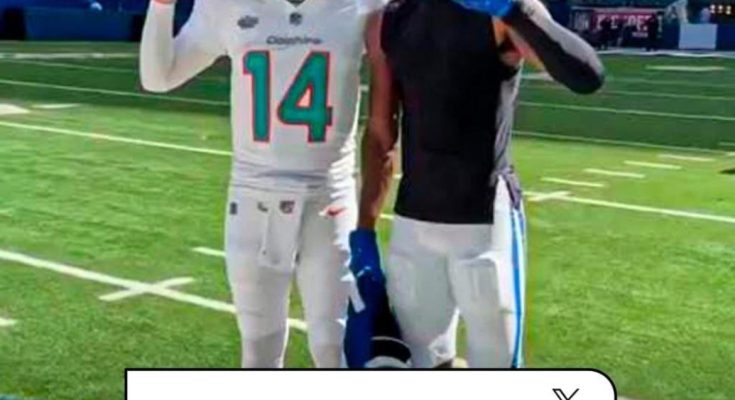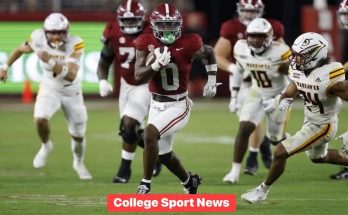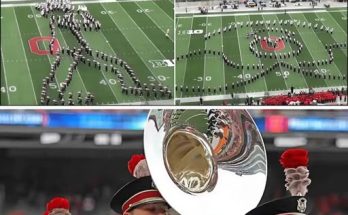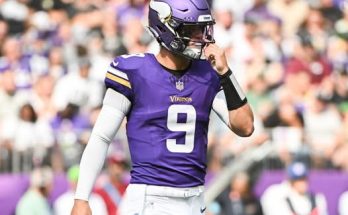The story of college teammates reuniting at the professional level always carries with it a certain magic. It speaks to shared history, to bonds formed in locker rooms and on practice fields, and to the unique chemistry that only comes when athletes spend formative years pushing one another toward greatness. Such is the case for former Texas Longhorns quarterback Quinn Ewers and wide receiver Adonai Mitchell, who have now found themselves back together in the big leagues after once forming one of the most dangerous quarterback-receiver duos in college football. Their reunion represents more than just a nice storyline; it is a tale of development, resilience, and unfinished business that could reshape how both are remembered in the next chapters of their careers.
For Ewers, the journey to the pros has been one lined with immense pressure and expectation. From his days as a highly touted high school recruit, he was often labeled as the next generational quarterback prospect, a player destined to not just succeed at the collegiate level but to eventually transform an NFL franchise. His decision to commit to Texas was viewed as a pivotal moment for a program hungry for national relevancy again, and his early career showed flashes of brilliance mixed with the typical growing pains of a young signal-caller. While he was not always perfect, Ewers demonstrated the kind of arm talent and field vision that scouts salivate over. He matured into a leader, learning to navigate adversity, and began to understand that his journey was never meant to be defined by one season or one setback.
Mitchell’s path was slightly different but equally compelling. He had already established himself on the big stage before transferring to Texas, having been a part of Georgia’s national championship run. When he arrived in Austin, expectations were high, but he quickly proved that he was more than capable of delivering on them. His combination of size, speed, and reliable hands made him a nightmare for opposing defenses, and his ability to step up in crucial moments helped define his reputation. He was not just a deep threat but a versatile receiver who could be trusted in third-down situations, red-zone opportunities, and any scenario requiring poise under pressure. At Texas, he became a perfect complement to Ewers, providing him with a reliable target that could change the game with a single catch.
Together, Ewers and Mitchell developed a synergy that energized the Longhorns’ offense and captured the imagination of fans. Their timing improved week by week, their connection on back-shoulder throws and downfield shots becoming a hallmark of the team’s attack. When Ewers trusted his arm to fit the ball into tight windows, it was often Mitchell on the other end, making highlight-reel plays that reminded everyone just how dangerous the duo could be when firing on all cylinders. This connection did not just elevate their stats; it elevated Texas football, injecting belief that the program could compete at the highest level once more.
Fast forward to their professional reunification, and the narrative takes on even greater weight. It is rare in the NFL for a quarterback and receiver with shared collegiate success to end up back together, but when it happens, it carries an undeniable advantage. Chemistry is not something that can be manufactured overnight. While NFL offenses are complex and demand adaptation, the pre-existing trust between Ewers and Mitchell allows them to skip steps other pairings may struggle with early on. Ewers already knows how Mitchell likes to attack leverage, how he adjusts mid-route, and how he positions his body on contested catches. Mitchell, in turn, knows the cadence of Ewers’ drops, the subtle cues that signal a scramble, and the confidence needed to anticipate where the ball will be delivered.
From a franchise perspective, this reunion is nothing short of a gift. Young quarterbacks often benefit immensely from having familiar targets, especially during the early years of their professional careers when confidence can make or break development. The presence of Mitchell not only gives Ewers a trusted ally on the field but also provides emotional stability off it. Entering the NFL is a daunting transition, but having a former teammate who has walked alongside him through previous challenges ensures that Ewers will not be facing this new chapter alone. Likewise, Mitchell benefits from the comfort of catching passes from a quarterback whose tendencies he already knows, allowing him to hit the ground running against elite defenders.
Fans of the Longhorns, of course, are thrilled to see their former stars back together again. The nostalgia of those Saturdays in Austin where Ewers dropped back and delivered strikes to Mitchell down the sideline is alive and well, only now the stage is bigger and the stakes even higher. For many Texas faithful, this reunion represents the continuation of a story they never wanted to see end. It is as if the unfinished business of their college careers is now being written on Sundays, giving them a second chance to prove their partnership can thrive at the highest level.
Their individual growth since leaving Texas cannot be overlooked either. Ewers, entering the league, has had to refine his mechanics, sharpen his processing speed, and adjust to the speed of professional defenses. He has shown strides in reading coverages, anticipating blitzes, and delivering the ball under duress. Meanwhile, Mitchell has refined his route running, improved his ability to separate against elite corners, and continued to showcase his knack for making tough catches in high-pressure moments. Their reunion does not simply pick up where it left off; it is an elevated version of their past connection, one sharpened by the lessons of college football and the demands of the professional game.
Of course, challenges lie ahead. Chemistry alone does not guarantee success, and the NFL is filled with defenses that specialize in disrupting timing and exposing weaknesses. Both Ewers and Mitchell will need to adapt to the schemes, physicality, and consistency required at the professional level. Injuries, competition for targets, and the natural growing pains of young players in the league are all realities that cannot be ignored. Yet, if there is a duo equipped to navigate those challenges, it may very well be these two former Longhorns who have already proven their resilience time and time again.
What makes their story so captivating is that it represents more than just football. It is about persistence, about the importance of relationships, and about the ways in which shared experiences can create bonds strong enough to endure the shifting landscapes of athletic careers. Ewers and Mitchell are not just teammates; they are reminders that the paths athletes walk are often intertwined in unexpected and beautiful ways. Their reunion is proof that sometimes fate has a way of aligning talent, friendship, and opportunity in ways that capture the imagination of fans and inspire future generations.
Looking ahead, the potential for Ewers and Mitchell to become one of the league’s most exciting tandems is very real. Their blend of youth, skill, and shared history gives them a unique advantage in an environment where every fraction of a second matters. If they can translate their college success into consistent professional production, they could redefine what it means for college teammates to carry their legacy into the NFL. For now, their reunion is a story worth celebrating, one that highlights the magic of sports and the enduring power of connection.
Former Texas Longhorns Quinn Ewers and Adonai Mitchell have reunited, and in doing so, they have given fans a storyline rich with potential, history, and hope. Their journey together is far from over, and as they take the field in the big leagues, the world will be watching to see if the sparks that once lit up Austin can now ignite under the brightest lights of all. It is a story still unfolding, and one that reminds us why we watch, why we care, and why the bond between teammates can sometimes be the most powerful force in sports.



